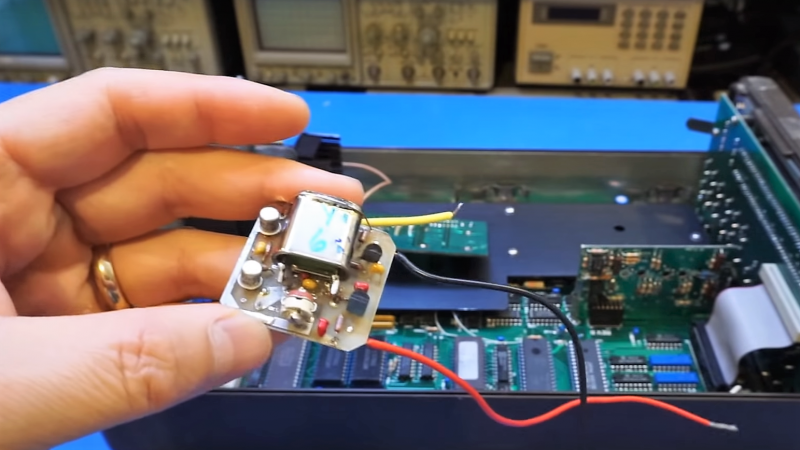Sure, we all love fixing stuff, but there’s often a fine line between something that’s worth repairing and something that’s cheaper in the long run to just replace. That line gets blurred, though, when there’s something to be learned from a repair.
This wonky temperature-compensated crystal oscillator is a good example of leaning toward repair just for the opportunity to peek inside. [Kerry Wong] identified it as the problem behind a programmable frequency counter reading significantly low. A TCXO is supposed to output a fixed frequency signal that stays stable over a range of temperatures by using a temperature sensor to adjust a voltage-controlled oscillator that corrects for the crystal’s natural tendency to vary its frequency as it gets hotter or colder. But this TCXO was pretty old, and even the trimmer capacitor provided was no longer enough to nudge it back in range. [Kerry] did some Dremel surgery on the case and came to the conclusion that adding another trim cap between one of the crystal’s leads and ground would help. This gave him a much wider adjustment range and let him zero in on the correct 10-MHz setting. [Mr. Murphy] still runs the show, though – after he got the TCXO buttoned up with the new trimmer inaccessible, he found that the frequency was not quite right. But going from 2 kHz off to only 2 Hz is still pretty good.
Whether it’s the weird world of microwave electronics or building a whole-house battery bank, it’s always fun to watch [Kerry]’s videos, and we usually end up learning a thing or two.
















ALL crystals drift as they age. All go faster with time. This is true even on deluxe dewars flask ovenized models.
ALL go faster? Abracon says, “Typical Crystal Aging: ± 5 ppm per year”.
And the tests I’ve done with my DS1054Z suggest it has slowed by 1ppm over 3 years.
http://nerdralph.blogspot.com/2015/07/rigol-ds1054z-frequency-counter-accuracy.html
At least all the ovenized models I’ve worked on ALL got faster with time. That included HP, Ovenaire, Spectracom and maybe a dozen others I don’t recall the mfg of. Worked in several high end cal labs. Mostly didn’t bother with TCXOs.
Faster, yes. My understanding is that the acceleration of the quartz slab literally throws particles of quartz off.
Aging rate on HP10811A (Agilent, Keysite, whatever their name is this week…) is ~5 E-10 per day. Which is < 0.2 ppm / year. Before pocket sized rubidium oscillators came along (developed for cellphone industry) the 10811A was the cats meow for high stability frequency refference for counters and synths. About a $1000 option in 1980s pricing. Rubidium standards were big 3RU and Cesium about 9RU sized. (But even the 5061 cesium used a 10811A for short term stability.)
And sometimes there’s other fun to be had with bad oscillators:
https://thecavepearlproject.org/2018/02/03/measuring-temperature-with-two-clocks/
I thought the TX part generally meant they had an oven to keep the crystal at a consistent temperature. If it was drawing 5ma there was no heating going on. I would like to have looked more carefully at the big crystal to see if it did not have something under it or even another set of leads coming out of the case. Also the transistors made me think something else may be going on. The two metal canned ones struck me as the ones for the oscillator but the plastic ones looked like the oven control. As the OP discovered, a proper repair of a precision device is not as simple as it sounds.
Constant [high] temperature – that’s an OCXO.
O as in “oven’.
I should have known that. Thank you.
Well, unless extremely lucky or the temperature coeficient of that trim cap was carefully chosen, which seems not, surely it ruins the environmental TCXO frequency stability.
That kind of fix may be good enough for a Controlled Xtal Oscillators but definitely not for a Temperature Compensated Xtal Oscillator.
Right that it was already borked so it doesn’t matter but I won’t call it fixed.
A better solution probably would be to meassure the actual trim capacitance and then use the closest value NPO cap to bring the frequency back to nominal.
*good enough for a Oven Controlled Xtal Oscillator